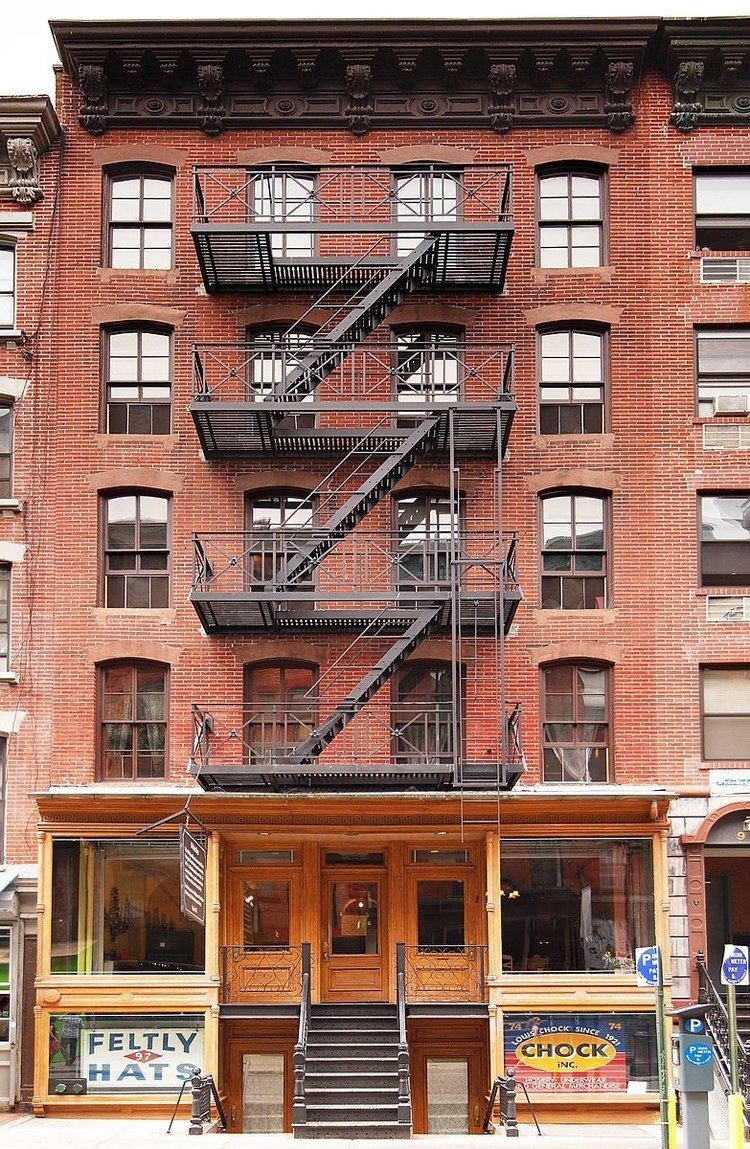Added to NRHP May 19, 1992 Designated NHS November 12, 1998 Year built 1863 | NRHP Reference # 92000556 Designated NHL April 19, 1994 Phone +1 212-982-8420 | |
 | ||
Address 103 Orchard St, New York, NY 10002, USA Hours Open today · 10AM–6:30PMTuesday10AM–6:30PMWednesday10AM–6:30PMThursday10AM–8:30PMFriday10AM–6:30PMSaturday10AM–6:30PMSunday10AM–6:30PMMonday10AM–6:30PM Similar Orchard Street, Eldridge Street Synagogue, Museum of the City of New York, Frick Collection, Madame Tussauds New York Profiles | ||
Lower east side tenement museum
The Lower East Side Tenement Museum, located at 97 Orchard Street in the Lower East Side neighborhood of Manhattan, New York City, is a National Historic Site. The five-story brick tenement building was home to an estimated 7,000 people, from over 20 nations, between 1863 and 1935. The museum, which includes a visitors' center down the block, promotes tolerance and historical perspective on the immigrant experience.
Contents
- Lower east side tenement museum
- A look inside the lower east side tenement museum
- History
- Exhibits collections and programs
- The Tenement House Act
- References
A look inside the lower east side tenement museum
History
The building at 97 Orchard Street was contracted by Prussian-born immigrant Lukas Glockner in 1863 and was modified several times to conform with the city's developing housing laws. When first constructed, it contained 22 apartments and a basement level saloon. Over time, four stoop-level and two basement apartments were converted into commercial retail space, leaving 16 apartments in the building. Modifications over the years included the installation of indoor plumbing (cold running water, two toilets per floor), an air shaft, and gas followed by electricity. In 1935, rather than continue to modify the building, the landlord evicted the residents, boarded the upper windows, and sealed the upper floors, leaving only the stoop-level and basement storefronts open for business. No further changes were made until the Lower East Side Tenement Museum became involved with the building in 1988. As such, the building stands as a kind of time capsule, reflecting 19th and early 20th century living conditions and the changing notions of what constitutes acceptable housing.
In spite of the restoration, some parts of the upper floors are unstable and remain closed.
The Tenement Museum was founded in 1988 by Ruth J. Abram and Anita Jacobson. The Museum's key property, the tenement at 97 Orchard Street, was designated a National Historic Landmark on April 19, 1994. The National Historic Site was authorized on November 12, 1998. It is an affiliated area of the National Park Service but is owned and administered by the Lower East Side Tenement Museum. The site received a Save America's Treasures matching grant for $250,000 in 2000 for preservation work. In 2001 the museum was awarded the Rudy Bruner Award for Urban Excellence silver medal. In 2005, the museum was among 406 New York City arts and social service institutions to receive part of a $20 million grant from the Carnegie Corporation, which was made possible through a donation by New York City mayor Michael Bloomberg. The National Defense Authorization Act for the 2015 fiscal year expanded the National Historic Site designation to also include the tenement at 103 Orchard Street.
The Tenement Museum attracted some negative press in 2007 related to its employees seeking union membership as well as for its planned acquisition of the building at 99 Orchard Street through eminent domain in 2002.
Exhibits, collections, and programs
The museum's exhibits and programs include restored apartments and shops open daily for public tours, depicting the lives of immigrants who lived at 97 Orchard Street between 1869 and 1935, such as Irish and Italian Catholic and European Jewish families. The museum also provides a documentary film and offers tours with costumed interpreters for portraying the building's former residents, tastings of their communities typical food, and neighborhood walks. The museum's tours place the immigrant's lives in the broader context of American history. The museum also has an extensive collection of historical archives and provides a variety of educational programs.
The Tenement House Act
There were many Tenement House Acts during the 1800s and 1900s. However, there were three particular Acts that changed the living conditions in housing today. Those three Tenement House Act were: The Tenement House Act of 1867, The Tenement House Act of 1879, and The Tenement House Act of 1901 which is part of the New York State Tenement House Act.
The first tenement house act was called, The Tenement House Act of 1867, also known as “the Old Law”. It was the country's first comprehensive housing reform law. The law required buildings to have fire escapes and at least one toilet for every 20 tenants, and to be connected to the city sewers if possible. However, many people (tenement owners) did not follow the law, so it had little effect. Then came the second Tenement House Act which was called The Tenement House Act of 1879, also known as “the Old Law” and was followed by the 1867 law. Many buildings were outlawing the construction of buildings like 97 Orchard Street that had interior rooms without windows. The 1879 law required all rooms to be open onto the street, the rear yard, or an air shaft. There were no fresh air any space for the tenant to escape the building if there was an accident. This led owners to the development of the "dumb-bell" tenement plan. Then came the third Tenement House Act which was called The Tenement House Act of 1901, also known as “The New Law.” The government notice that many of the tenement building were really dangerous and unlivable. The 1901 law required building to have amenities such as running water, gas, light, and Ventilation. Also, the Dumb-bell tenement plan was outlawed. Since previous Tenement House Act did not help change the housing condition the law allow the Tenement House Department to inspect these buildings and enforce the new regulations.
